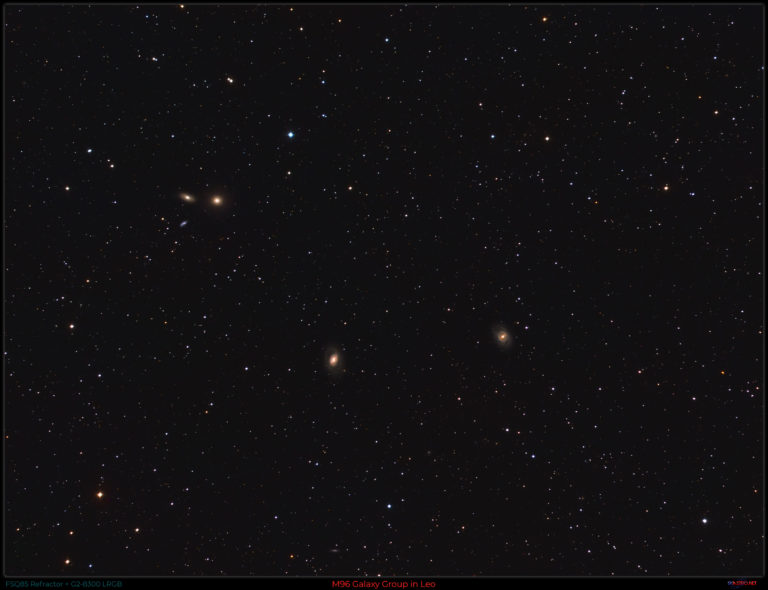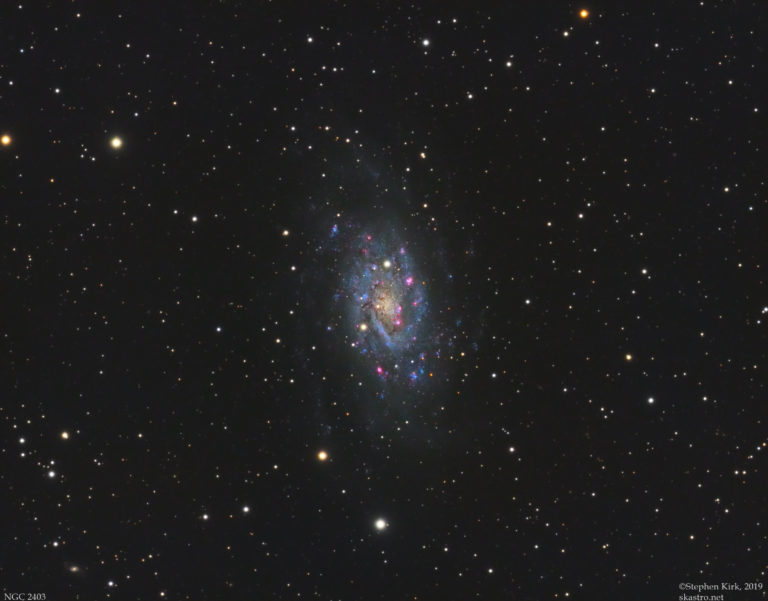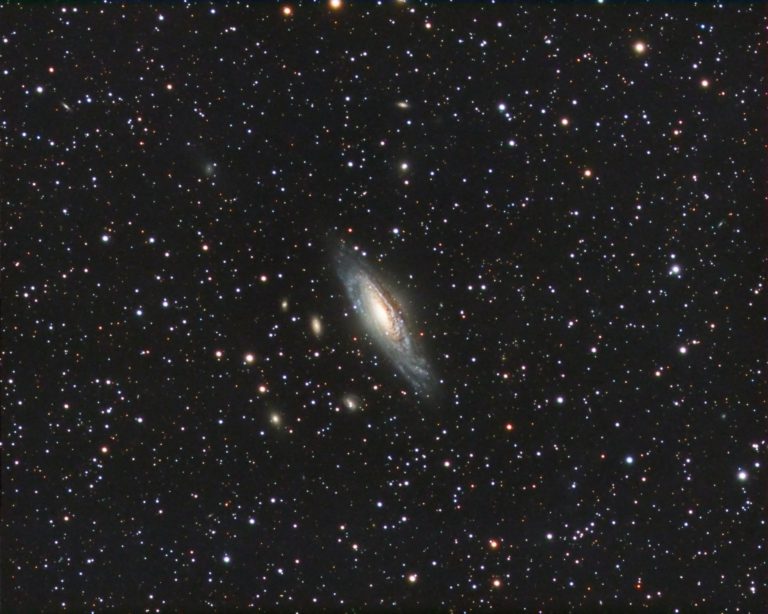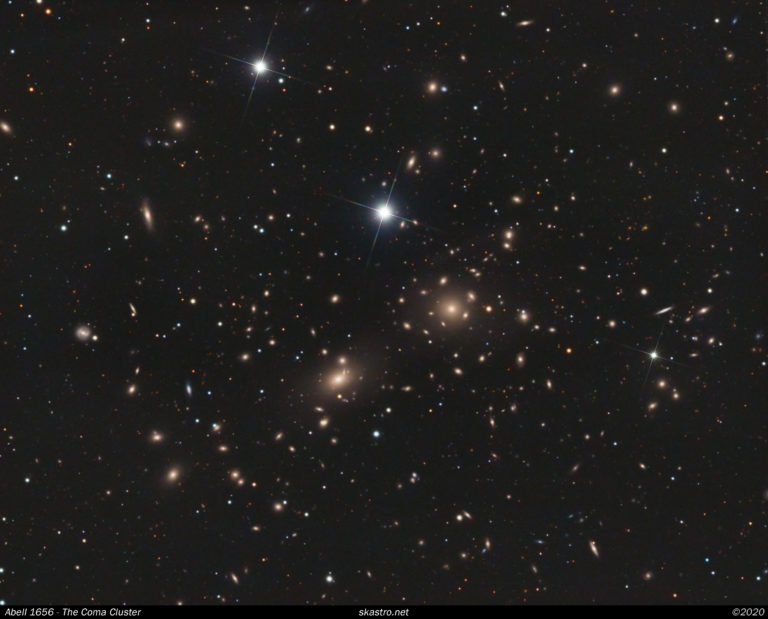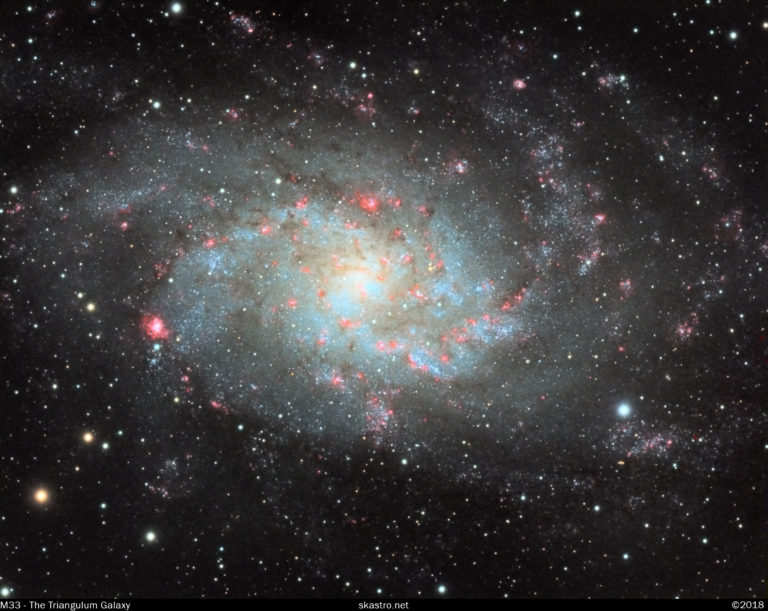The M96 Group is a cluster of galaxies in the constellation of Leo. Not to be confused with the separate and arguably more famous Leo triplet. The M96 group contains three Messier galaxies (M95, M96 and M105) and many fainter galaxies in the background. The three main galaxies are about 35 million light years away and are easily visible in small telescopes. M96 Group Image Technical Data Technical Information Imaged from my backyard, March 2019, in Nottingham, UK. I used my FSQ85 refractor with 0.73 reducer and my Moravian instruments G2-8300 CCD camera and Astrodon LRGB filters. Mount is my MESU200 and guided with an Off-Axis guider. Image acquisition data:Luminance 11 x 600s 1×1; Red 9 x 300s 2×2; Green 10 x 300s 2×2; Blue 10 x 300s 2×2 M96 Group Annotated
NGC 2403 is a spiral galaxy located about eight million light years away in the constellation of Camelopardalis in the Northern hemisphere. It is an outlying member of the M81/M82 group. You will note that it bares a striking resemblance to M33 and contains huge HII star forming regions. NGC2403 is much smaller than our own galaxy, being only about 50000 light years in diameter as opposed to about 120000 light years for our own Milky Way galaxy. It is not known why a smaller galaxy like this should have such huge HII regions that dwarf those of our own, larger galaxy. NGC 2403 Image Technical Data Imaged from my backyard, March 2019, in Nottingham, UK. I used my TEC 140 refractor with Atik 460 CCD camera and Astrodon LRGB filters. Image acquisition data, everything binned 1×1 Luminance 29 x 600s; Red 12 x 300s; Green 12 x 300s; Blue 12…
NGC 7331 (Caldwell 30) is a spiral galaxy about 46 million light years away in the constellation of Pegasus. It is a vibrant and colorful galaxy, often referred to as the Milky Way’s “twin” due to it being of a similar size and mass to our own galaxy. It is visible in amateur telescopes as a faint smudge if the sky is dark. In the images below, the smaller galaxies to the left of the main galaxy are a chance line-of-sight alignment. These four galaxies are much more distant than NGC 7331 (about 320 million light years) and are nothing to do with the main galaxy. This collection of galaxies (NGC 7331 and the distant background galaxies are collectively referred to as the Deer Lick Group named after the Deer Lick gap in the mountains of North Carolina by astronomer Tomm Lorenzin who liked to observe from there. NGC 7331…
Abell 1656 Abell 1656 – The Coma Cluster – is a cluster of galaxies in the constellation of Coma Berenices, located about 320-330 million lights years away. The cluster is dominated by two supergiant elliptical galaxies NGC 4874 and NGC 4889 which are visible in this image in the centre below the bright blue star (which is local to our own galaxy). NGC 4889 is the largest and most massive galaxy in the local universe and is vsoble in modest amateur telescopes despite the great distance. It contains the most massive black hole yet discovered. The galaxy itself is estimated to have more than 1000 times the mass of opur own Milky Way galaxy. Image Technical Data Image acquired spring 2020 (during the Coronavirus lockdown) in my backyard in Nottingham, UK. It was acquired with TEC 140 refractor (with field flattener) with Atik460 CCD camera and Astrodon LRGB Gen2 E…
I have completed several images of the famous Triangulum Galaxy – M33, over the years. This is one of the most photographed objects in the sky and with good reason; it is a beautiful face on spiral galaxy that is the second closest major galaxy after Andromeda. It is bright and colourful and responds well to all types of imaging, whether with a DSLR or CCD, camera lens or telescope. It is probably the second “go to” target to photograph for astro photography beginners after the Andromeda galaxy. The image below is a version captured with the TEC 140 refractor and Atik 460 CCD camera and is the total of about 12 hours of LRGBHa data captured from my backyard observatory in Nottingham, UK in 2018. You can see it fills the frame very nicely. M33 The Triangulum Galaxy M33 Annotated M33 Inverted Image Technical Data Image acquired spring 2018…

